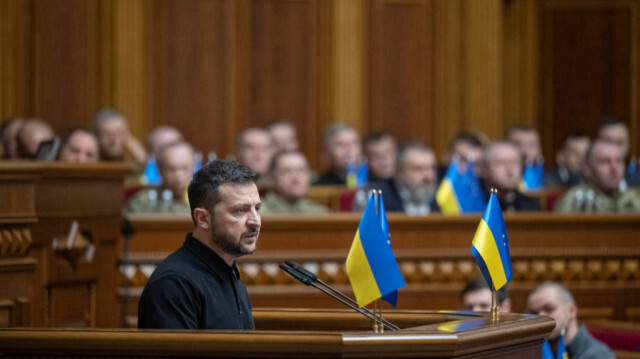
Plan, which includes NATO integration and substantial financial aid, is highly aspirational, even speculative
Ukrainian President Volodymyr Zelenskyy's recent presentation of his "victory plan" in parliament represents a high-stakes gambit in the ongoing conflict with Russia. Unveiled on Oct. 16, 2024, amid critical NATO discussions and European Union (EU) dialogues, this strategic blueprint emerges as public sentiment increasingly favors peace negotiations. While ambitious in scope, the plan raises fundamental questions about its feasibility and the complex trade-offs between military resolve and diplomatic pragmatism.
- The promises and dangers of Zelenskyy's 'victory plan'
At the heart of Zelensky's plan lies a bold demand for NATO membership, revealing both the promise and peril of Ukraine's strategic vision. Baltic states and Poland have publicly championed Ukraine's NATO aspirations, but other alliance members remain wary. Their concern isn't just about Russia's reaction, it's about the practical implications of admitting a country in active conflict. NATO's Article 5 mutual defense clause could immediately draw the entire alliance into a confrontation with Russia, a scenario that countries like Germany and France seem eager to avoid. This tension between Ukraine's security needs and NATO's strategic caution underscores a fundamental challenge in Zelenskyy's approach.
The plan's military components, including access to long-range weapons for striking Russian targets, represent a notable shift in strategic thinking. However, Western allies remain hesitant about providing such capabilities, concerned about potential escalation and Russia's possible responses. The classified non-nuclear deterrence strategy, while intriguing, lacks transparent mechanisms for implementation and international oversight.
On the economic front, Zelenskyy's proposal to seek joint investments in Ukraine's natural resources, especially in lithium and uranium, calls for careful consideration. While these resources could indeed attract Western investment, the practical challenges of developing such industries during wartime and the security implications of strategic resource management demand more detailed consideration. Moreover, the proposal lacks specific safeguards against potential corruption and mechanisms for equitable profit-sharing with international partners.
The vision of Ukrainian forces replacing certain United States military contingents in Europe, while bold, faces significant practical and political hurdles. Key European nations, while still officially supportive of Ukraine, may hesitate to rely on a military still engaged in active conflict and requiring substantial reconstruction. This aspect of the plan also raises questions about long-term funding and training requirements that neither Ukraine nor its allies have fully addressed.
- A sustainable solution is now required
The plan, which includes NATO integration and substantial financial aid, is highly aspirational, even speculative. It is largely reliant on the US support, which may be uncertain if former President Donald Trump is reelected. European leaders, like German Chancellor Olaf Scholz, are also reconsidering their earlier gung-ho positions. Scholz has recently called for renewed diplomatic efforts to end the war in Ukraine, but his proposal has largely been met with indifference both at home and abroad.
Worse still, Zelenskyy's reliance on escalating the conflict rather than seeking peace talks reveals a desperate gamble to maintain his position, risking further casualties and diplomatic isolation in the long run. Many feel that Zelenskyy's "victory plan" is primarily a personal survival kit for the president amid a faltering military campaign. The Ukrainian president's dismissal of key figures like Defense Minister Rustem Umerov and Gen. Kyrylo Budanov has raised eyebrows in many Western capitals, stocking concerns about Ukraine's military leadership at a critical juncture. Recent setbacks and withdrawals in the Donbas front have not assuaged those apprehensions.
The Ukrainian people are also showing signs of war fatigue. Latest polling data showing that 57% of Ukrainians favor peace talks signals a crucial shift in domestic dynamics. Such polls reflect a growing recognition that military victory alone may not provide a sustainable solution. This changing public sentiment highlights the need to explore diplomatic alternatives more seriously. A multilateral peace initiative, possibly mediated by neutral countries and involving security guarantees from both Western and non-Western powers, could present a more viable path forward. Such an approach might address Russia's security concerns while safeguarding Ukrainian sovereignty, potentially breaking the diplomatic impasse that Zelenskyy's military-focused strategy has been unable to resolve.
As Ukraine navigates these complex challenges, the international community's patience and resource commitment remain crucial yet uncertain. Western support, while substantial, shows signs of strain as domestic priorities in supporting nations compete with aid to Ukraine. This reality adds urgency to finding a sustainable resolution beyond military solutions.
The bottom line is that Zelenskyy's “victory plan” is insufficient to end the conflict with Russia. Unless he integrates a diplomatic strategy alongside military deterrence, the plan risks leading Ukraine into a prolonged and costly deadlock. The current approach overlooks the complex geopolitical realities at play, threatening not only Ukraine's future but also European stability. Without a clear evolution towards diplomacy, Zelenskyy's plan remains more of an ambitious, unrealistic vision than a pragmatic solution to the ongoing war. A failure to adapt could exacerbate the conflict further.

